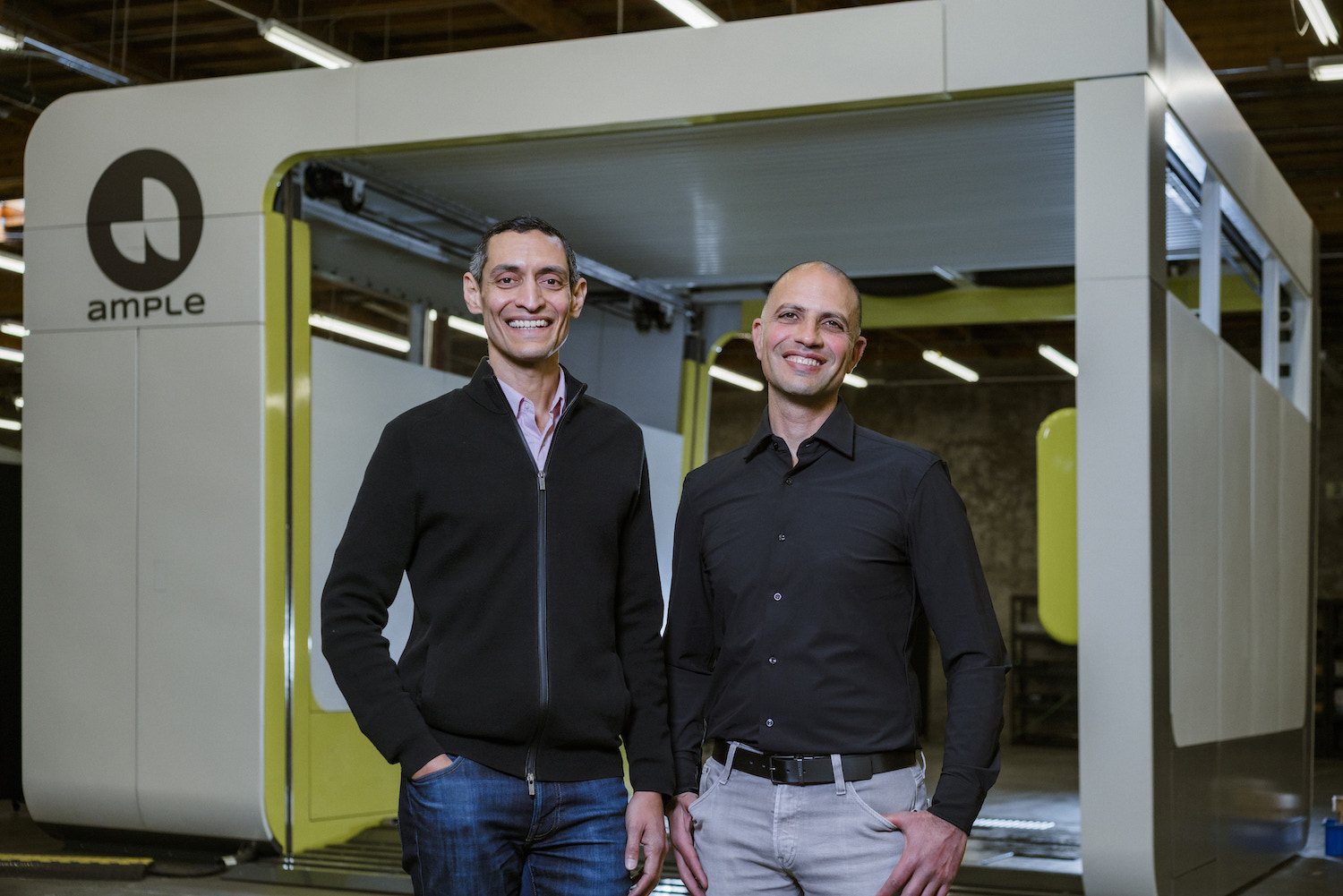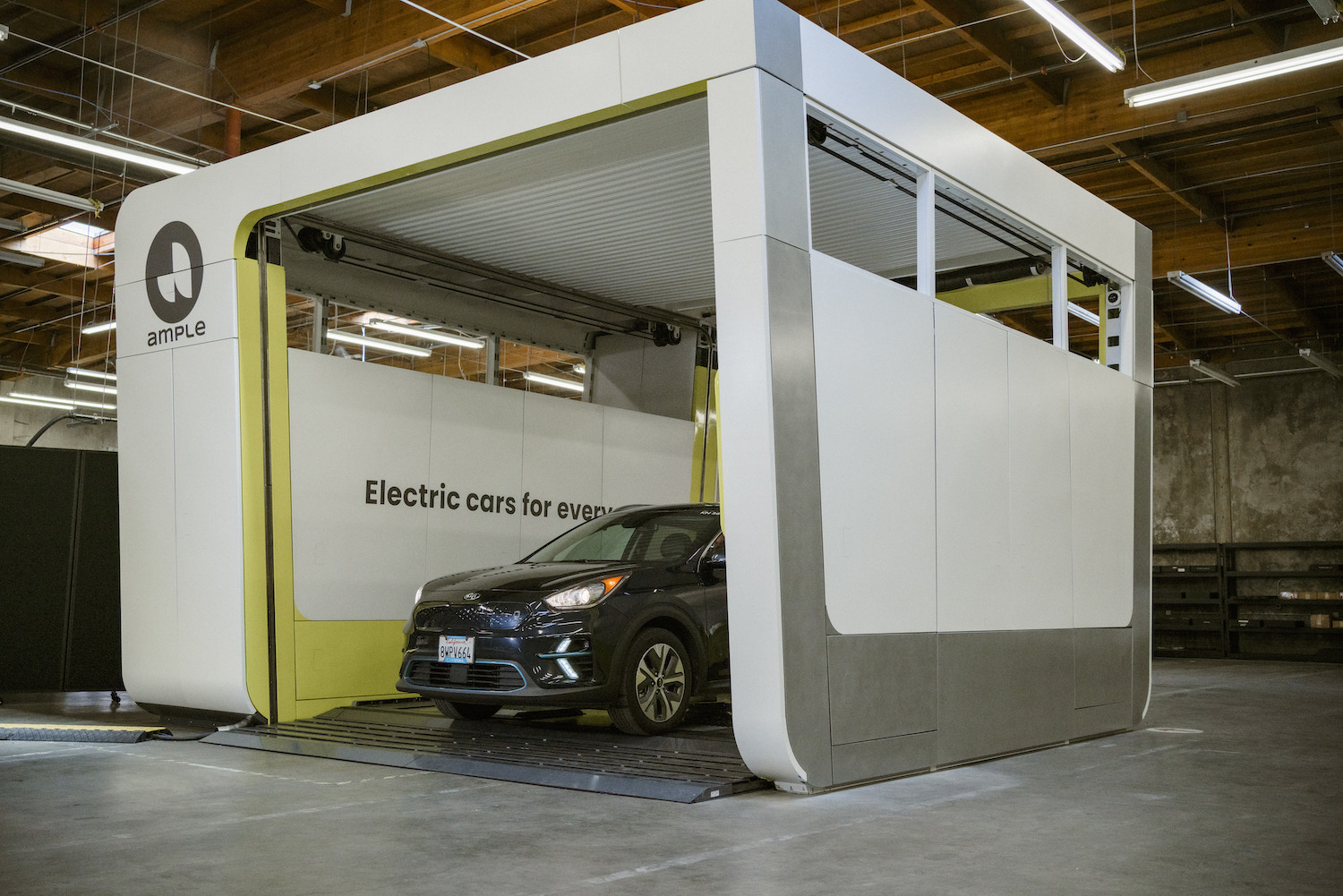
When drivers need a fresh charge, they can maneuver onto one of Ample’s battery swapping pods, where discharged batteries are robotically removed and new ones are installed beneath the vehicle.
The vast majority of the world’s automakers have coalesced around the concept of building their electric vehicles with fixed batteries. But some still see battery swapping as a better solution for getting a fresh charge, quickly, into an EV.
Even the fastest charging vehicles available today cannot match the speed of battery swapping. So, why spend 20 minutes charging — and often much longer — when you can get fully charged batteries installed in just five minutes?
Today, the answer is obvious. There isn’t a battery swapping solution in place at scale, at least not in the U.S. But as a concept, it’s nothing new, and dates back toward the advent of the automobile itself.
Many early vehicles were electric, and the first experiments with battery exchange have been traced back to the 1890s. By 1912, General Electric commercialized a “battery service," allowing electric vehicle owners to swap batteries for a monthly fee and per-mile charge. But, of course, things were about to change.
“What ended up destroying battery swapping is that gasoline worked extremely well,” John de Souza, president and co-founder of Ample, a San Francisco-based electric mobility company, told TriplePundit. But now that we’re in a new era of EVs, de Souza and his team at Ample believe it’s time to take another look at it.
“The only way to get electric vehicles to work is to make something that works as well as gas,” de Souza asserted. “We wanted something that would be fast, we wanted to work across vehicles, and we wanted to have something we could deploy efficiently.”
To that end, Ample has developed its own battery swapping system. It incorporates both a battery pack, which Ample claims can be retrofitted into any EV, along with its own free-standing, battery-swapping pods, which can be set up in about three days.
Ample’s system comes at a time, though, when EVs are already working pretty well without swappable batteries. EV market share is growing, with new models being released all the time. And importantly, advancements in battery technology are bringing each new generation of EVs closer to the convenience of gasoline-powered cars.
So, why does Ample think we need this now? Is its system a solution in search of a problem?
Fixed batteries are getting better, so why change?
De Souza offered a number of inherent limitations which he thinks EVs with fixed batteries will always have, and that Ample’s system avoids.
“A Tesla spends a third of its energy just taking this huge battery around,” de Souza said, referring to the heavy battery packs necessary for longer electric range. “But what if you could just put in the right size of the battery you need? Your car is more efficient. And when you need more range, put more batteries in.”
Similarly, “What if you could upgrade your technology?" he continued. "As new battery chemistries come out, you can actually benefit from those and not be stuck with the one you got seven years ago.”
And what about when the battery's warranty expires after eight years, at a time when it may have degraded? This renders a car “basically worthless,” de Souza said. EV batteries cease to be useful when they degrade to 80 percent of their original energy density, “but you are paying for the full 100 percent,” he said. “What if you could actually use the car for 15 years like a lot of people do, and not have to get rid of it?”
All questions worth asking. Yet building a successful business around battery swapping has proved elusive. Famously, and after much promise, Palo Alto-based Better Place folded just six years after its founding with huge debt. So, what’s different now?

Battery swapping reimagined
“The big difference with Better Place was they tried to standardize the battery and ask all the [auto manufacturers] to standardize, too — that doesn’t work,” de Souza explained. “Fundamentally, we completely changed that.”
Ample developed two key innovations which he believes will bring it success while avoiding the pitfalls that sank Better Place.
Firstly, Ample ensured it could use the same battery cells in any car. And secondly, it designed a system that works across vehicles from different manufacturers, without the manufacturers having to change anything.
To be clear, this is not a do-it-yourself deal, though. Ample does require cooperation with the carmaker for each model to ensure the startup's batteries mesh properly with the car both mechanically and electrically.
In order to get Ample’s battery pack into a vehicle, an “adaptor plate” is made which follows the same size and contours of the carmaker's original battery. Once this plate is fitted into the same footprint, Ample loads in its own battery modules. It’s the modules that are subsequently swapped when the vehicle is in service.
Secondly, Ample ensures its battery solution follows all the necessary software protocols of each vehicle to ensure the battery gives the car all the information it needs to work seamlessly.
Once on the road, when drivers need a fresh charge, they maneuver onto one of Ample’s battery swapping pods, where discharged batteries are robotically removed and new ones are installed beneath the vehicle.
The number of modules installed is flexible — for example, fewer modules can be put in for commuting, while more modules can be added for longer trips. The customer then pays for what they use, calculated based on the number of battery modules installed and the amount of energy consumed.
Ample’s pods handle recharging duty, optimizing for off-peak and/or renewable energy availability while also balancing the use cycles to make sure battery cell life is maximized.
Another important feature: Since Ample owns the end-to-end lifecycle of the battery cells, when they reach end-of-life, it can ensure the cells are recycled. Most vehicle and battery manufacturers don’t close that loop.

Can Ample break into the mass market?
It’s the early days, but Ample’s product is already in use. For about two years, it’s partnered with Uber in supporting a group of drivers in the San Francisco Bay Area. Ample’s technology is installed in two vehicle types — the Nissan Leaf and the Kia Niro — and drivers have access to 12 swapping stations.
So far, the Uber project has been a success. Drivers have avoided substantial downtime they would otherwise spend charging, while the operating costs have proven cheaper than both DC fast charging and gasoline, de Souza said.
Going forward, Ample has plans for further deployments in California, as well as new markets in Japan and Spain. It’s focused on fleet operators initially, as well as retrofitting passenger cars, but has its sights set on trucks in the long term.
At this point, Ample’s technology is certainly niche. But the way de Souza talked about the opportunities indicated he believes this model is a better mousetrap for the EV industry as a whole. Is it realistic that Ample could disrupt the segment?
Since there’s already considerable momentum behind the fixed-battery EV paradigm — and a related industry around charging infrastructure — closing the gap on that head start won’t be easy, especially as that business model rapidly iterates and improves.
Nevertheless, Ample is currently working with five auto manufacturers, indicating at least some are open to entertaining a different approach, even if only alongside their own fixed-battery vehicles.
Crucially, though, we asked de Souza whether car companies actually want to give up developing their own battery technologies. After all, they compete on range and charging times — it’s how they differentiate themselves.
“They definitely want more flexibility from the battery,” de Souza replied, explaining how automakers have to worry about commitments on battery sourcing and chemistries amid ever-changing regulatory conditions. Maybe solutions like Ample’s would take some of this pain away, leaving makers to just build, as de Souza put it, “phenomenal cars.”
Images courtesy of Ample

Phil Covington holds an MBA in Sustainable Management from Presidio Graduate School. In the past, he spent 16 years in the freight transportation and logistics industry. Today, Phil's writing focuses on transportation, forestry, technology and matters of sustainability in business.














